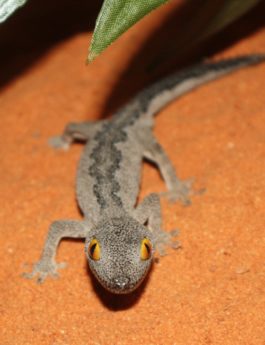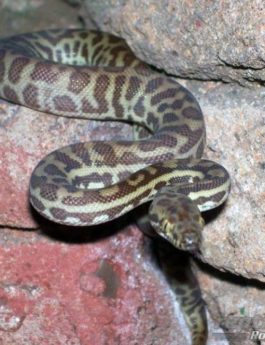Children’s Pythons are among Australia’s smallest pythons, they are relatively slender snakes, with their head being only slightly wider than their neck. the body colour ranges from pale yellowish-brown, to dark purplish-brown through various shades of red. Children’s pythons have a distinct pattern of small blotches that contrast with ground colour, they are sometimes patterned at hatching and lose the dorsal pattern as they grow. Their tummy is a soft whitish with a opalescent sheen. A dark streak is generally present from to nostril, through the eye to the temple.
The Children’s Python can be found across northern Australia, from northern Western Australia and the Northern Territory, to north-western Queensland. They are usually found in association with rocky outcrops within grasslands, woodlands and monsoon forests. They shelter beneath rock, bark, ground litter and in caves, termite mounds and hollow logs.
Terrarium: Children’s Pythons do not require an enclosure with very much height, however if given the correct environment with climbing enrichment they will explore their enclosure. The enclosure needs to be large enough to provide multiple hide rocks and maintain a thermal gradient, a terrarium that is 90x45x45cm (WxDxH) would be suitable to house a pair of mature Children’s Pythons.
Lighting & heating: UVB lighting is not essential to Children’s Pythons, however a low 2.0 spectrum fluorescent globe can be used for viewing purposes. Heating can be provided with a heat tile, mat or cord to maintain a ground surface temperature of 32°C in the hot spot. Ambient heat can be provided with an infrared heat globe to maintain a daytime temperature of 32°C in the warm end and 20°C in the cool end, on warmer days you may not need to turn on the heat globe as the ambient temperature of the enclosure may already be high enough. A thermometer should always be used to monitor the temperature within the enclosure.
Furnishings: It is important to provide your Children’s Python with plenty of hide caves throughout, a water bowl at the cool end, and artificial plants will give coverage and decoration. Large Logs and vines can be used within the enclosure to provide climbing enrichment. A pet bedding wood chips such as Chipsi or Critter Crumble can be used as a substrate.
Food in captivity: All snakes in captivity must be fed dead food. A Children’s Python will eat a variety of frozen and thawed mice, rats and chickens of appropriate sizes. On average they will have 1-2 food items every 7-10 days.
The essentials:
- Terrarium of appropriate size
- Tummy heating
- Thermometer
- Infrared Heat globe
- Water bowl
- Substrate
- Hide caves
Foliage for shelter





